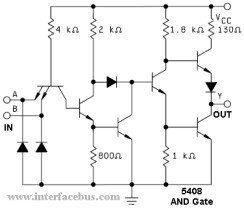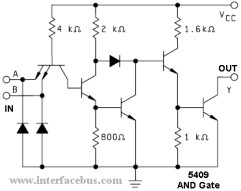Definitions of Technical Terms
"A"
"B"
"C",
"D",
"E",
"F",
"G",
"H",
"I",
"J",
"K",
"L",
"M",
"N",
"O",
"P",
"Q",
"R",
"S",
"T",
"U",
"V",
"W",
"X",
"Y",
"Z"
Transistor Transistor Logic
Transistor Transistor Logic [TTL] is a series of integrated logic chips that accept external digital inputs through a multi-emitter transistor and than produce a digital output using another transistor, and also uses transistors to reproduce and interconnect the required logic functions.
There are two general classes of devices, a 7400 series that operate to commercial temperatures and a 5400 series that operate to military temperature ranges. However the internal structure of both grades are basically the same and could be used as a replacement for one another [except for the operational temperature range]. A 5408 dual input AND gate is shown to the right.
There are a large number of TTL sub-families each designed to enhanced a particular aspect of its performance, normally speed or power dissipation [Speed vs Power Chart]. Selecting a particular logic family is determined by the electrical characteristics; Comparing Different Logic Families.
The internal structure is fundamentally identical between the different logic families. In fact many of the different sub-families are identical except for the values of the internal resistors used to bias the transistors. Lower value resistors are used when higher speed is required [74xx series], while higher value resistors are used when low power is the design criteria [74Lxx series]. For example, values are changed again to obtain the 74Hxx [High-Speed] series. However the 74Hxx series is made even faster by using the same interconnect structure and resistor values, but exchanging the normal transistors with Schottky transistors, producing the 74Sxx series of parts.
Each of the TTL families are compatible with each other; however some classes may run off 5 volts while other classes may operate from 3.3 volts. All logic devices or components that have TTL compatible inputs, will respond to outputs received from a TTL type logic gate, power from the same voltage level. Each sub-class of devices switches or changes state at defined voltage levels.
The standard output structure for TTL parts is the Totem Pole [Push-Pull] as used with the 5408, but there are also Open Collector Output devices such as the 5409 shown below. The uncommitted collector allows the IC to use, and than switch to any output voltage.
CMOS logic families are not Transistor Transistor Logic ICs, although they do have TTL Compatible Switching levels. CMOS devices such as 74Cxx, 74HCxx and so on, use CMOS gates within the chip and do not use transistors. Their outputs are all TTL compatible because they switch rail to rail, but their input requirements are different than TTL devices. CMOS devices which have TTL compatible inputs will have a 'T' designation; for example 74HCTxx.
There were a few other logic families that came before TTL devices, none of which are used or found any longer. Obsolete logic families include; Direct-coupled transistor logic (DCTL), Resistor-transistor logic (RTL), Resistor-capacitor-transistor logic (RCTL), and Diode-transistor logic (DTL), each of which were slower and consumed more power. The last logic family, which preceded TTL, was the DTL family, but suffered from loading issues and slow switching times. The DTL series was also the first logic series that was second sourced by several manufacturers.










